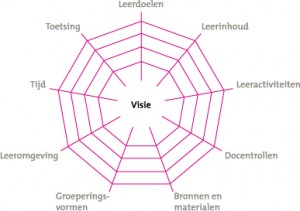Developing a curriculum
Het ontwikkelen van een curriculum (NL)
‘A good curriculum is more than the sum of its separate parts’
When looking for an unambiguous definition for the term curriculum, one quickly realises that this is not an easy task. This is because a curriculum can be defined from different perspectives and levels, among which: the programme of the student, the ideal or achieved curriculum, or a curriculum on macro-, meso-, or micro level. The definition of Taba (1962) is still applicable, even though it is 50 years old by now: a curriculum is a… ”plan for learning”. More concretely: ”All curricula, no matter what their particular design, are composed of certain elements. A curriculum usually contains a statement of aims and of specific objectives; it indicates some selection and organisation of content; it either implies or manifests certain patterns of learning and teaching, whether because the objectives demand them or because the content organisation requires them. Finally, it includes a programme of evaluation of the outcomes.” (p.10). The Utrecht Education Model can be interpreted as the curriculum of Utrecht University.
Cohesion in a curriculum
The core of the a curriculum is formed by a vision on education. The goals, content of learning, and assessment play an important role here, as do the learning activities and the role of the lecturer. All these components are interconnected: courses build upon each other, lecturers work based on of the programme and coordinate with each other, the work formats elicit the desired learning processes, the students are tested on things that matter, receive timely feedback on their progress, and the means are employed in a balanced manner. This cohesion can be visualised using the curriculum spiderweb by Van den Akker (2003; see figure 1).
Even though the terminology seems to mainly refer to secondary education, this figure clearly depicts the complexity of a curriculum. All components relate to the vision and ideally also to each other. A change in one component can thus influence other components.
Developing a curriculum
Developing a new curriculum is best started by jointly, and in conjunction with the professional field, determining the intended learning outcomes: what is the minimum a student know and be capable of at the end of the programme. In existing programmes, the curriculum development often takes the form of optimising the cohesion of the programme. New developments in the field or society can make different work formats necessary; lecturers need to become proficient in new roles; the assessment needs to be adjusted; et cetera. When each lecturer makes improvements or innovations on their own, you do get better courses, but this can reduce the cohesion in the curriculum. The development a cohesive curriculum in terms of content, skills, didactics, and assessment is referred to as constructive alignment (Biggs, 2003). A defining characteristic is that it is based on what students should have learned and the end of their studies and adjust education and assessment to this end. Cohesion in the curriculum can be created by plotting long-term or continuous learning tracks on:
- content
- skills
- didactics
An example
We will use the psychology programme (Dutch) at the Utrecht University as example. The content structure of the educational programme of psychology has a wide basis, an orientation in the first year of the Bachelor on the specialisation in the Master. In addition to over the years, the horizontal cohesion is important. The content is chosen and aligned per study phase.
The educational programme of psychology also contains a learning track academic skill, such as research, writing, and academic thinking skills. Here too, there is a structure: from introductory to advanced. Questions you encounter when developing long or continuous learning tracks are: what makes a course ‘introductory’, or ‘basic’, when is a course ‘in-depth’, and when is it ‘specialist’ or ‘advanced’? Assessment is focussed on knowledge, insight, and skills and is preferably addressed in an integrated way. Here too, it is important to create alignment and cohesion to ensure that a student is not faced with the same assessment format every time. It is, therefore, recommended to create an assessment programme.
One can also approach long learning tracks from a didactic perspective. A structure is implemented in the psychology programme that is based on the level of responsibility: from ‘lecturer directed, to shared direction, to student directed’. This responsibility can be aimed at the choice of assignments, cases or problems, learning goals, support with self-study, assignments, and IT, refencing, and sources. A different example is a structure based on the complexity of the learning tasks: from simple to complex. The complexity can be:
- in the increasing complexity of the tasks themselves.
- in the variation in mental models that the students should master
- conceptual models like hierarchical, comparative, contrasting, etc.
- structural models, for example structure of a scientific article
- causal models, for example a tree structure
- and/or the increase of cognitive effort that is needed (structure on cognitive strategies)
References
- Akker, J. van den (2003). Curriculum perspectives: An introduction. In J. van den Akker, W. Kuiper, & U. Hameyer (Eds.), Curriculum landscapes and trends (pp. 1-10). Dordrecht: Kluwer Academic Publishers.
- Berg, I. van den, Ritzen, M. & Pilot, A. (2012). Codesign als adviesstrategie bij curriculumontwikkeling. Een casusstudie van een onderwijsinnovatieproces. Tijdschrift voor Hoger Onderwijs, 30(1), 5-22.
- Biggs, J. (2003). Teaching for quality learning at university. Maidenhead: Open University Press.
- McKenney, S., Nieveen, N. & Akker, J. van den (2006). Design research from a curriculum perspective. In J. van den Akker, K. Gravemeijer, S. McKenney, & N. Nieveen (Eds.), Educational design research. (pp 68-90). London: Routledge.
- Taba, H. (1962). Curriculum development: theory and practice. New York, NY: Harcourt, Brace & World.
- Valcke, M. (2010). Onderwijskunde als ontwerpwetenschap. Een inleiding voor ontwikkelaars van instructie en voor toekomstige leerkrachten. Gent: Academic Press.


